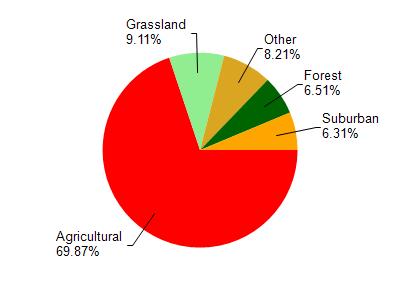Rock
No
No
No
Fish and Aquatic Life
Overview
Rock River Water Quality Management Plan, Lower Rock River Appendix. WT-668-2002. South Central Region, WDNR.
Spring Brook (T1N R14E S31) is a seepage-and-spring-fed, nine-mile-long tributary to Turtle Creek. The stream is shallow and its flow is greatly reduced in dry years; the stream receives flow from the Clinton wastewater treatment plant and cooling water from Hormel. Possible temperature alterations to Spring Creek from the Hormel discharge are of concern. Biotic survey work would determine what, if any, biological impacts point source discharges have had on this creek. The stream supports a diverse array of minnow species.
Date 2002
Author Aquatic Biologist
Historical Description
From: Ball, Joseph R., and Ronald J. Poff, Lake and Stream Classification Project. Surface Water Resources of Rock County, Department of Natural Resources, 1970.
Surface Acres -7, Miles = 10.5, Gradient = 16.5 feet per mile.
A spring and seepage fed stream arising southwest of Clinton Junction and flowing southwest to enter Turtle Creek near Beloit. Forage species dominate the fishery due to low flow; the stream has almost ceased to flow in dry years. About 6 acres of fresh meadow wetland border the stream. Access is possible from five county highways.
Date 1970
Author Surface Water Inventory Of Wisconsin
Impaired Waters
Spring Brook, from the mouth to 9.7 miles upstream, was evaluated in the 2022 cycle: phosphorus levels were above listing thresholds as outlined in 2022 WisCALM. This stream segment was added to the 2022 Impaired Waters List.
Date 2022
Author Ashley Beranek
Condition
Wisconsin has over 84,000 miles of streams, 15,000 lakes and milllions of acres of wetlands. Assessing the condition of this vast amount of water is challenging. The state's water monitoring program uses a media-based, cross-program approach to analyze water condition. An updated monitoring strategy (2015-2020) is now available. Compliance with Clean Water Act fishable, swimmable standards are located in the Executive Summary of Water Condition in 2018. See also the 'monitoring and projects' tab.
Reports
Recommendations
Monitor Water Quality or Sediment
Questionable Result (999?) Needs further investigation.
Management Goals
Wisconsin's Water Quality Standards provide qualitative and quantitative goals for waters that are protective of Fishable, Swimmable conditions [Learn more]. Waters that do not meet water quality standards are considered impaired and restoration actions are planned and carried out until the water is once again fishable and swimmable
Management goals can include creation or implementation of a Total Maximum Daily Load analysis, a Nine Key Element Plan, or other restoration work, education and outreach and more. If specific recommendations exist for this water, they will be displayed below online.
Monitoring
Monitoring the condition of a river, stream, or lake includes gathering physical, chemical, biological, and habitat data. Comprehensive studies often gather all these parameters in great detail, while lighter assessment events will involve sampling physical, chemical and biological data such as macroinvertebrates. Aquatic macroinvertebrates and fish communities integrate watershed or catchment condition, providing great insight into overall ecosystem health. Chemical and habitat parameters tell researchers more about human induced problems including contaminated runoff, point source dischargers, or habitat issues that foster or limit the potential of aquatic communities to thrive in a given area. Wisconsin's Water Monitoring Strategy was recenty updated.
Grants and Management Projects
| Project Name (Click for Details) | Year Started |
|---|
|
|
Monitoring Projects
| WBIC | Official Waterbody Name | Station ID | Station Name | Earliest Fieldwork Date | Latest Fieldwork Date | View Station | View Data |
|---|
|
|

Watershed Characteristics
Spring Brook is located in the Turtle Creek watershed which is 288.47 mi². Land use in the watershed is primarily agricultural (69.80%), grassland (9.10%) and a mix of forest (6.50%) and other uses (14.50%). This watershed has 339.80 stream miles, 590.58 lake acres and 6,590.97 wetland acres.
Nonpoint Source Characteristics
This watershed is ranked Not Available for runoff impacts on streams, Not Available for runoff impacts on lakes and High for runoff impacts on groundwater and therefore has an overall rank of High. This value can be used in ranking the watershed or individual waterbodies for grant funding under state and county programs.However, all waters are affected by diffuse pollutant sources regardless of initial water quality. Applications for specific runoff projects under state or county grant programs may be pursued. For more information, go to surface water program grants.